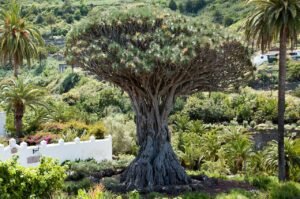
Araucaria heterophylla: A Comprehensive Tree Biography
Araucaria heterophylla, known commonly as Norfolk Island Pine, is an elegant evergreen; native to this small island in the Pacific Ocean-Norfolk Island. Symmetrical and adaptable, this tree has enchanted botanists, gardeners, and plant enthusiasts all-over the world. Unique features and its ability to thrive both indoors and outdoors have made it famous for ornamental purposes. We are looking here at the origins, physical characteristics, ecological importance, cultivation practices, and their popular applications of Araucaria heterophylla to compile a well-built biography on this amazing tree species.
Origins and Habitat
Area of Natural Distribution
Araucaria heterophylla is native to Norfolk Island, lying between New Zealand and New Caledonia. Even the fairly marooned subtropical climate of that volcanic island acts up to the very best growing conditions for this tree. Up to 65 meters in height, the Norfolk Island Pine can achieve in its indigenous habitat.
Historical Background
First described in 1802 by the British botanist James Edward Smith, Araucaria heterophylla was originally named for the fact that it bears different kinds of leaves (with “hetero” meaning different, and “phylla,” leaves). Over the years, both a landscaping tree and a houseplant in pots have made it popular all over the world.
Distinctive Characteristics
Mode of Growth
The above-mentioned state of growth is characteristic of Araucaria heterophylla, which produces horizontal branches uniformly arranged in perfect whorls. Such a structure imparts a characteristic tiered appearance to the tree.
Bark and Leaves
Bark: Grayish-brown rough fissured bark.
Leaves: The foliage is altered as the tree gets older. Juvenile leaves are soft bright green and similar to needles, however adult leaves are scale-like and more rigid and darker green than juvenile.
Cones
It bears the distinction of being monoecious because it produces both male and female cones in one tree. Male cones are cylindrical and shed pollen while female cones are round, woody, and contain seeds.
Ecological Importance
Wildlife Habitat
Araucaria heterophylla is used as a host for various bird species and insects within its native environment. Its seeds serve as a food source for indigenous animals.
Soil Stabilisation
This tree’s extensive root system prevents soil erosion, especially in coastal and windy areas where it is commonly planted.
Carbon Sequestration
Like all trees, Araucaria heterophylla contributes to the fight against climate change by absorbing carbon dioxide from the air.
Cultivation and Maintenance
Soil Requirements
Well drained, sandy or loamy soil, with a slightly acidic to neutral pH, is preferred.
Keep away from heavy clay soils which retain water.
Light Preferences
Sheds a bright, indirect sunlight within the indoors.
For outdoors, it is required in full sun to partial shade.
Watering Needs
Wet the soil at all times but not waterlogged.
Reduce watering during the winter season in order to stop root rot.
Temperature and Humidity
Ideal temperature range is 10°C to 22°C (50°F to 72°F).
When in relatively dry indoor conditions, it prefers moderate humidity and may need misting.
Fertilization
A balanced, water-soluble fertilizer should be applied in the growing season: spring and summer.
Prevent over-fertilizing, for it may harm the roots.
Pruning
Minimal pruning is easy. Thin and remove dead or damage branches to give it a good shape.
Common Uses
Ornamental Use
It is usually utilized when being decorative as an indoor plant, especially in the holiday season, to replace the Christmas trees.
Gardens and parks are also planted for aesthetic value.
Timber
Araucaria heterophylla is not very much harvested within the native range for timber, which is lightweight and easy to work with.
Air Purification
This is like many indoor plants as it contributes to the purification of air through toxin reduction and oxygen release.
Challenges in Cultivation
Pests and Diseases
Common Pests: Mealybugs, spider mites, and scale.
Diseases: Rooth ailments due to overwatering and fungal attacks.
Environmental Stress
Sensitive to extremes of temperature; prolonged exposure to dry air.
Frost damage, which may be manifested in foliage.
Interesting Facts
Norfolk Island Pine though is popularly known, is not a true pine tree, but belongs to the family Araucariaceae.
Has been used for life Christmas trees due to its perfect cone shape.
It is one of the few living survivors of an ancient lineage of flowering plants dating back to the Jurassic period.
Norfolk Island Pines can live for several hundred years under ideal conditions.
FAQ
- norfolk island pine monocot or dicot?
The Araucaria heterogeneous, very popularly known as the Norfolk Island Pine, is neither a monocot nor a dicot. It is a member of the gymnosperms, which are the ancient seed-producing plants that reproduce by cones and not flowers, to make a long story short.
- Can I grow Araucaria heterophylla indoors?
Indeed, it is a fairly commonly used indoor plant considering its size and attractiveness. Make sure you keep it in bright indirect light and humid conditions.
- How fast does the Norfolk Island Pine really grow?
It’s slow-growing, with around 15 cm to a foot of possible annual growth in the best environmental conditions.
- Is Araucaria heterophylla poisonous to pets?
Toxic in nature to cats and dogs on ingestion, symptoms are vomiting, lethargy.
- Lower branches of my Norfolk Island pine are going brown.
Too little to insufficient water, or watery to be under-watering light might be the culprit. Check its care conditions.
- Can it be propagated?
Propagates by seed or cuttings, and conditions are specific for germination of the seeds.
- Is repotting necessary?
Yes, repotting every 2 to 3 years or when it gets root bound. Choose a new pot that is a little bigger than the existing pot.




